新概念英语第一册知识点梳理
(完整版)新概念第一册知识点整理,推荐文档
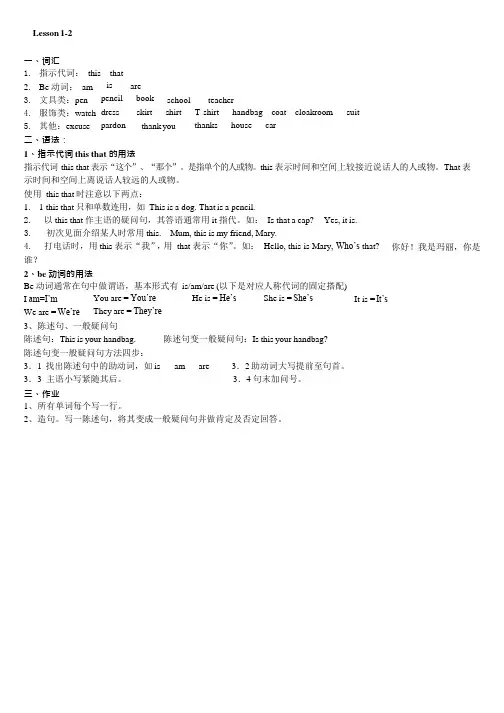
1. I am Rice. (改否定句) 2. His son is a teacher. (改否定句) 3. Mr. Clinton and his wife are busy. (改为否定句) 4. Lily is seven. (改一般疑问句) 5. Are your son a student?(改错)
Lesson 1-2 小测试
Read and choose.
My name Lisa. I
from china.
A. is / am
B. are / is
C. is / are
this a car?
A. am
B. is
C. are
Is this your bag?
A. No, it is.
B. Yes, it isn’t.
2. 非常感谢。
Lesson 3-4
一、词汇 形容词性物主代词: my your his her 名词: umbrella ticket number son 形容词:new good nice 副词:here too 动词:please meet 英语中对男性及女性的称呼: Mr. Sir 二、语法:
Lesson 1-2 小测试 Read and choose. My name Lisa. I
from china.
A. is / am
B. are / is
C. is / are
this a car?
A. am
B. is
C. are
Is this your bag?
A. No, it is.
B. Yes, it isn’t.
B:
?
A: Is this your pencil?
新概念英语第一册所有语法点汇总)
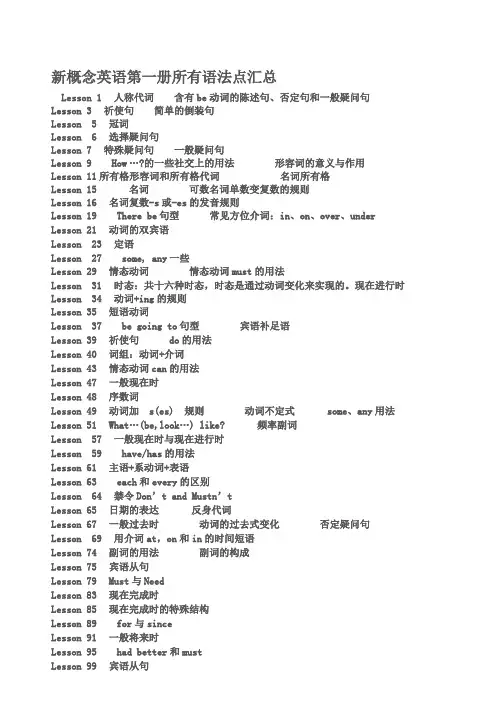
新概念英语第一册所有语法点汇总Lesson 1 人称代词含有be动词的陈述句、否定句和一般疑问句Lesson 3 祈使句简单的倒装句Lesson 5 冠词Lesson 6 选择疑问句Lesson 7 特殊疑问句一般疑问句Lesson 9 How…?的一些社交上的用法形容词的意义与作用Lesson 11所有格形容词和所有格代词名词所有格Lesson 15 名词可数名词单数变复数的规则Lesson 16 名词复数-s或-es的发音规则Lesson 19 There be句型常见方位介词:in、on、over、under Lesson 21 动词的双宾语Lesson 23 定语Lesson 27 some, any一些Lesson 29 情态动词情态动词must的用法Lesson 31 时态:共十六种时态,时态是通过动词变化来实现的。
现在进行时Lesson 34 动词+ing的规则Lesson 35 短语动词Lesson 37 be going to句型宾语补足语Lesson 39 祈使句do的用法Lesson 40 词组:动词+介词Lesson 43 情态动词can的用法Lesson 47 一般现在时Lesson 48 序数词Lesson 49 动词加s(es) 规则动词不定式some、any用法Lesson 51 What…(be,look…) like? 频率副词Lesson 57 一般现在时与现在进行时Lesson 59 have/has的用法Lesson 61 主语+系动词+表语Lesson 63 each和every的区别Lesson 64 禁令Don’t and Mustn’tLesson 65 日期的表达反身代词Lesson 67 一般过去时动词的过去式变化否定疑问句Lesson 69 用介词at,on和in的时间短语Lesson 74 副词的用法副词的构成Lesson 75 宾语从句Lesson 79 Must与NeedLesson 83 现在完成时Lesson 85 现在完成时的特殊结构Lesson 89 for与sinceLesson 91 一般将来时Lesson 95 had better和mustLesson 99 宾语从句Lesson 100 直接引语和间接引语Lesson 101 反意疑问句Lesson 103 too与enough的用法Lesson 105 动词不定式Lesson 107 形容词的比较级和最高级Lesson 111 形容词的平级比较级Lesson 113 so与neither引导的简短回答Lesson 116 不定代词Lesson 117 过去进行时概念和结构Lesson 119 过去完成时Lesson 121 定语从句Lesson 123 感叹句Lesson 125 must, have to和needn’tLesson 127 表示猜测和推断的情态助动词must和can’tLesson 131 情态助动词may表示可能性Lesson 133 需改变时态的间接陈述句Lesson 135 Let的用法Lesson 137 条件从句Lesson 141 被动语态新概念英语第一册语法点归纳大纲新概念英语第一册语法点归纳新概念一共144课,其中单课为课文,双课为语法和练习。
新概念英语第一册知识点总结
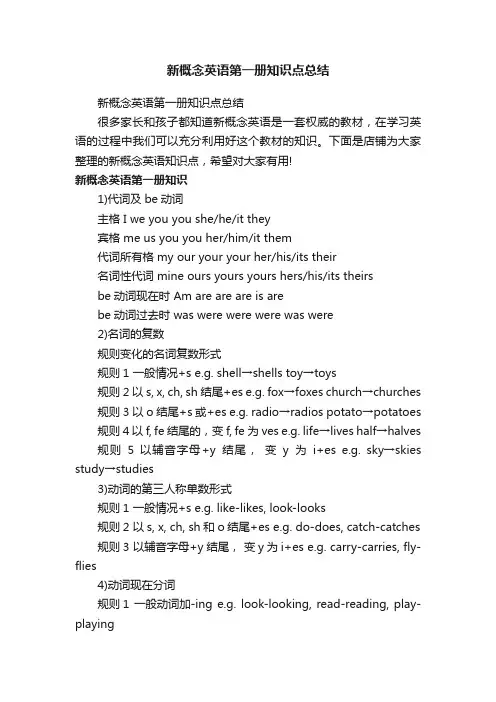
新概念英语第一册知识点总结新概念英语第一册知识点总结很多家长和孩子都知道新概念英语是一套权威的教材,在学习英语的过程中我们可以充分利用好这个教材的知识。
下面是店铺为大家整理的新概念英语知识点,希望对大家有用!新概念英语第一册知识1)代词及be动词主格 I we you you she/he/it they宾格 me us you you her/him/it them代词所有格 my our your your her/his/its their名词性代词 mine ours yours yours hers/his/its theirsbe动词现在时 Am are are are is arebe动词过去时 was were were were was were2)名词的复数规则变化的名词复数形式规则1 一般情况+s e.g. shell→shells toy→toys规则2 以s, x, ch, sh结尾+es e.g. fox→foxes church→churches 规则3 以o结尾+s或+es e.g. radio→radios potato→potatoes 规则4 以f, fe结尾的,变f, fe为ves e.g. life→lives half→halves 规则5 以辅音字母+y结尾,变y为i+es e.g. sky→skies study→studies3)动词的第三人称单数形式规则1 一般情况+s e.g. like-likes, look-looks规则2 以s, x, ch, sh和o结尾+es e.g. do-does, catch-catches 规则3 以辅音字母+y结尾,变y为i+es e.g. carry-carries, fly-flies4)动词现在分词规则1 一般动词加-ing e.g. look-looking, read-reading, play-playing规则2 以不发音的字母结尾的单词去e加-ing e.g. make-making, take-taking, arrive-arriving规则3 重读闭音节词结尾,即单词中只有一个元音字母,其后紧跟一个辅音字母的词,双写辅音字母再加-ing e. g. run-running, sit-sitting, get-getting, swim-swimming, stop-stopping5)动词过去式规则动词变化规则1 一般动词加-ed e.g. look-looked, watch-watched, play-played规则2 以e结尾的加-d e.g. make-maked, arrive-arrived规则3 以辅音字母y结尾的变y为i加-ed cry-cried, carry-carried 规则4 重读闭音节词结尾,即单词中只有一个元音字母,其后紧跟一个辅音字母的词,双写辅音字母再加-ed stop-stopped 过去式的读音在清辅音后面(除外)读/t/ e.g. walked, jumped在浊辅音和元音后读/d/ e.g. washed, watched在/t/,/d/后读/id/ e.g. waited, hated新概念英语基础知识点1.in+语言/颜色/衣帽等,表示使用某种语言或穿着……。
新概念英语第一册各课语法知识汇总
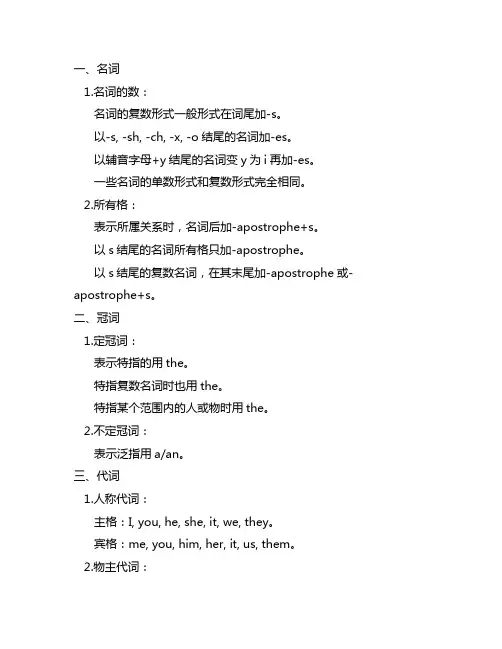
一、名词1.名词的数:名词的复数形式一般形式在词尾加-s。
以-s, -sh, -ch, -x, -o结尾的名词加-es。
以辅音字母+y结尾的名词变y为i再加-es。
一些名词的单数形式和复数形式完全相同。
2.所有格:表示所属关系时,名词后加-apostrophe+s。
以s结尾的名词所有格只加-apostrophe。
以s结尾的复数名词,在其末尾加-apostrophe或-apostrophe+s。
二、冠词1.定冠词:表示特指的用the。
特指复数名词时也用the。
特指某个范围内的人或物时用the。
2.不定冠词:表示泛指用a/an。
三、代词1.人称代词:主格:I, you, he, she, it, we, they。
宾格:me, you, him, her, it, us, them。
2.物主代词:形容词性物主代词:my, your, his, her, its, our, their。
名词性物主代词:mine, yours, his, hers, its, ours, theirs。
3.指示代词:this, that, these, those。
4.不定代词:some, any, no, every, each, many, much, few, little。
四、形容词1.形容词的用法:在名词前作定语。
在系动词之后作表语。
2.比较级和最高级:比较级:比较两者时,用比较级。
最高级:表示三者或三者以上之间的比较。
五、动词1.动词的三单形式:一般情况,动词第三人称单数在末尾加-s。
以辅音字母加y结尾的动词变y为i再加-es。
直接在词尾加-es的动词。
2.动词的现在进行时:am/is/are+动词的现在分词。
3.行为动词的过去式:动词过去式变化规则有规则动词和不规则动词。
六、副词1.副词的用法:修饰动词、形容词、副词。
表示时间、地点、原因、目的等。
2.比较级和最高级:副词比较级和最高级的构成。
七、介词1.介词的基本用法:表示方位、时间、原因、目的等。
新概念第一册每课知识点整理
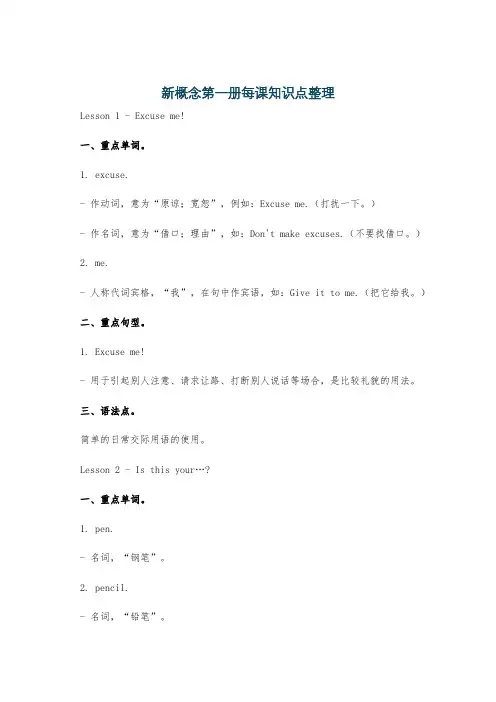
新概念第一册每课知识点整理Lesson 1 - Excuse me!一、重点单词。
1. excuse.- 作动词,意为“原谅;宽恕”,例如:Excuse me.(打扰一下。
)- 作名词,意为“借口;理由”,如:Don't make excuses.(不要找借口。
)2. me.- 人称代词宾格,“我”,在句中作宾语,如:Give it to me.(把它给我。
)二、重点句型。
1. Excuse me!- 用于引起别人注意、请求让路、打断别人说话等场合,是比较礼貌的用法。
三、语法点。
简单的日常交际用语的使用。
Lesson 2 - Is this your…?一、重点单词。
1. pen.- 名词,“钢笔”。
2. pencil.- 名词,“铅笔”。
3. book.- 名词,“书”。
4. watch.- 名词,“手表”;也可作动词,“观看”,如:watch TV(看电视)。
二、重点句型。
1. Is this your pen?- 这是一般疑问句,其结构为“be动词(is/are等)+主语+其他”,回答可以是“Yes, it is.”或者“No, it isn't.”三、语法点。
1. 一般疑问句的构成与回答。
2. 指示代词this的用法,用来指代离说话者较近的人或物。
Lesson 3 - Sorry, sir.一、重点单词。
1. umbrella.- 名词,“雨伞”。
2. please.- 副词,用于请求别人做某事时表示礼貌,如:Please open the window.(请打开窗户。
)二、重点句型。
1. Is this your umbrella?- 同Lesson 2中的一般疑问句结构。
2. Sorry, sir.- “sorry”表示歉意,“sir”是对男性的尊称。
三、语法点。
1. 继续巩固一般疑问句。
2. 尊称“sir”的用法。
Lesson 4 - Is this your…?一、重点单词。
新概念一册全部知识点总结
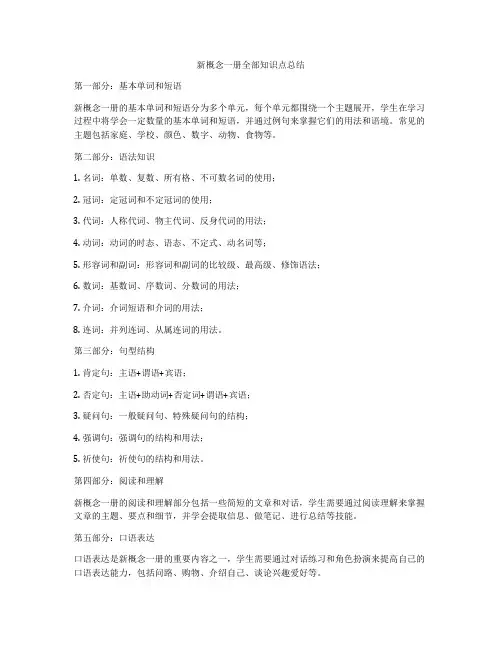
新概念一册全部知识点总结第一部分:基本单词和短语新概念一册的基本单词和短语分为多个单元,每个单元都围绕一个主题展开,学生在学习过程中将学会一定数量的基本单词和短语,并通过例句来掌握它们的用法和语境。
常见的主题包括家庭、学校、颜色、数字、动物、食物等。
第二部分:语法知识1. 名词:单数、复数、所有格、不可数名词的使用;2. 冠词:定冠词和不定冠词的使用;3. 代词:人称代词、物主代词、反身代词的用法;4. 动词:动词的时态、语态、不定式、动名词等;5. 形容词和副词:形容词和副词的比较级、最高级、修饰语法;6. 数词:基数词、序数词、分数词的用法;7. 介词:介词短语和介词的用法;8. 连词:并列连词、从属连词的用法。
第三部分:句型结构1. 肯定句:主语+谓语+宾语;2. 否定句:主语+助动词+否定词+谓语+宾语;3. 疑问句:一般疑问句、特殊疑问句的结构;4. 强调句:强调句的结构和用法;5. 祈使句:祈使句的结构和用法。
第四部分:阅读和理解新概念一册的阅读和理解部分包括一些简短的文章和对话,学生需要通过阅读理解来掌握文章的主题、要点和细节,并学会提取信息、做笔记、进行总结等技能。
第五部分:口语表达口语表达是新概念一册的重要内容之一,学生需要通过对话练习和角色扮演来提高自己的口语表达能力,包括问路、购物、介绍自己、谈论兴趣爱好等。
第六部分:听力训练新概念一册的听力训练部分主要包括一些简短的对话和独白,学生需要通过听力训练来提高自己的听力理解能力,并学会提取信息、概括主旨、回答问题等技能。
第七部分:写作技巧写作技巧是新概念一册的另一个重要内容,学生需要通过一些写作练习来提高自己的写作水平,包括书信、日记、口头通知等。
第八部分:语言运用语言运用是新概念一册的最后一个部分,学生需要通过语言运用来巩固和复习所学的知识点,包括语法练习、词汇练习、阅读理解练习等。
总结:新概念一册的知识点主要包括基本单词和短语、语法知识、句型结构、阅读和理解、口语表达、听力训练、写作技巧和语言运用等内容。
新概念英语第一册重点知识点概括
新概念英语第一册重点知识点概括一、固定搭配二、时态:一般现在时,现在进行时,现在完成时,一般过去时,过去进行时,过去完成时,一般将来时,过去将来时。
三、词性:动词现在分词、动词的过去式和过去分词。
形容词、副词的比较级与最高级。
助动词、情态动词、半情态动词的使用。
动词不定式。
反身代词、不定代词。
特殊疑问词。
四、句式:简单句、并列句、复合句(定语从句、if条件状语从句、宾语从句)。
五、语态:被动语态。
六、结构:There be结构。
七、语序:倒装。
第一部分:请您记住以下新概念英语一册1-144课的所固定搭配短语前面是英文,后面是对应的中文I beg your pardon 请您在重复(说)一遍Nice to meet you(too)(我也)很高兴见到你Look at…看…How do you do 你好Be careful 小心心A loaf of 一个A bar of 一条A bottle of 一瓶A pound of 一磅Half a pound of 半磅A quarter of 四分之一A tin of 一听Hurry up 快点Next door 隔壁Black coffee 不加牛奶的咖啡 White coffee 加牛奶的咖啡Come home from school 放学回家 Come home from work 下班回家In the morning 早上In the afternoon 下午In the evening 晚上At noon 中午At night 夜里At the moment 此刻What’s the time? 几点钟? Come upstairs 上楼Come downstairs 下楼 Hundreds of… 数以百计的…On the way home 在回家的途中 This morning 今天早晨This afternoon 今天下午 This evening 今天晚上tonight 今天夜里 Yeste rday morning 昨天早晨Yesterday afternoon 昨天下午 Yesterday evening 昨天晚上Last night 昨天夜里 The day before yesterday in the morning 前天早晨The day before yesterday in the afternoon 前天下午The day before yesterday in the evening 前天晚上The night before last 前天夜间 A low mark 分数很底A high mark 分数很高 She said to herself 她心中暗想The way to… 到…的走法 In fashion 流行的,时髦的I’m afraid… 我恐怕…I’m sure… 我确信,我肯定…A lot of 许多(用于肯定句) At all 丝毫、更本、一点也不Going on holiday 度假 Have beento… 到过…All the time 一直,始终 Drive into… 撞倒…For sale 供出售、出售 Have the last word 最后决定、最后才算The R.A.F. 英国皇家空军 Return ticket 往返票Next door to… 与…相邻,在…隔壁In five hours’time 在五小时之后。
新概念1知识点
新概念1知识点一、词汇。
1. 基础词汇。
- 数字:one, two, three等,要掌握数字的拼写、读音以及基本的数学运算表达,如“two plus three is five”(二加三等于五)。
- 家庭成员:father, mother, son, daughter, brother, sister等,学会描述家庭关系,例如“My father is a teacher”(我的父亲是一名教师)。
- 颜色:red, blue, green, black, white等,能够用颜色描述物品,如“This pen is blue”(这支笔是蓝色的)。
- 日常用品:pen, pencil, book, bag, desk, chair等,可用于描述周围环境或个人物品,如“There is a book on the desk”(桌子上有一本书)。
2. 动词短语。
- 起床:get up,例如“I get up at seven o'clock every morning”(我每天早上七点起床)。
- 去上学:go to school,如“He goes to school by bike”(他骑自行车去上学)。
- 吃(饭):have/eat,“I have breakfast at home”(我在家吃早饭)。
3. 方位介词。
- in:表示在……里面,如“There is a cat in the box”(盒子里有一只猫)。
- on:表示在……上面(表面接触),“The book is on the table”(书在桌子上)。
- under:表示在……下面,“The ball is under the chair”(球在椅子下面)。
二、语法。
1. 一般现在时。
- 概念:表示经常发生的动作或存在的状态。
- 结构:- 主语是第三人称单数(he/she/it等)时,动词要加 -s或 -es。
例如“He likes reading books”(他喜欢读书)。
新概念1知识点归纳总结
新概念1知识点归纳总结### 一、语言基础- 词汇量:掌握基础词汇,包括日常用语、常见名词、动词、形容词等。
- 语法结构:了解基本的语法规则,如主谓宾结构、时态变化等。
### 二、句子构建- 简单句:学会构建简单句,表达清晰的意思。
- 并列句:使用并列连词连接两个或多个简单句。
### 三、时态与语态- 一般现在时:表示经常发生的动作或状态。
- 一般过去时:描述过去发生的动作或状态。
- 进行时态:表示正在进行的动作。
### 四、疑问句和否定句- 一般疑问句:通过疑问词引导,询问信息。
- 特殊疑问句:使用特殊疑问词,询问具体细节。
- 否定句:表达否定意义,使用否定词。
### 五、直接引语与间接引语- 直接引语:直接引用别人的原话。
- 间接引语:转述别人的话,使用不同的语法结构。
### 六、条件句- 真实条件句:表达真实可能发生的情况。
- 非真实条件句:表达与现实相反的假设情况。
### 七、非谓语动词- 动名词:动词+ing形式,用作名词。
- 不定式:to+动词原形,表示目的或意图。
- 分词:现在分词(-ing形式)和过去分词(-ed形式),用作形容词。
### 八、定语从句- 限制性定语从句:对先行词进行限定。
- 非限制性定语从句:对先行词进行补充说明。
### 九、状语从句- 时间状语从句:表示动作发生的时间。
- 原因状语从句:说明动作发生的原因。
- 条件状语从句:表示动作发生的条件。
### 十、虚拟语气- 对现在情况的虚拟:表示与现实相反的愿望或假设。
- 对过去情况的虚拟:表示对过去的遗憾或假设。
### 十一、文章结构- 引言:文章开头,提出主题。
- 主体:详细阐述主题,提供论据。
- 结论:文章结尾,总结全文。
### 十二、写作技巧- 段落结构:每个段落包含主题句和支持句。
- 逻辑连接:使用逻辑连接词使文章更加连贯。
通过对新概念1的知识点进行归纳总结,可以更好地掌握英语基础,为进一步学习打下坚实的基础。
新概念英语第一册知识点梳理
Lesson 10 Look at…
如何描述他人的外 貌、年龄、性格、习 惯等特征
fat, thin, tall, short, dirty, clean, hot, cold, old, young, busy, lazy whose, blue, perhaps, white, catch
Lesson 11 Is this your shirt? Lesson 12 Whose is this …? This is my/your/his/her … Whose is that …? That is my/your/his/her … Lesson 13 A new dress Lesson 14 What colour ’s your … Lesson 15 Your passports, please.
Lesson 22 Give me/him/her/us/them a… Which one?
与 Lesson 21 同
empty, full, large, little, sharp, small, blunt, box, glass, cup, bottle, tin, knife, fork, spoon
Lesson 28 Where are they?
描述物体的位置
trousers
near the window. 4) There are some magazines on the television. 1) There are some cigarettes on the dressing table. 2) They are near that box. Shut the door, please.
give, one, which
- 1、下载文档前请自行甄别文档内容的完整性,平台不提供额外的编辑、内容补充、找答案等附加服务。
- 2、"仅部分预览"的文档,不可在线预览部分如存在完整性等问题,可反馈申请退款(可完整预览的文档不适用该条件!)。
- 3、如文档侵犯您的权益,请联系客服反馈,我们会尽快为您处理(人工客服工作时间:9:00-18:30)。
语用功能
词汇短语
句型语法
如何与人搭讪;如何 Lesson 1 Excuse me! 对物品所属进行问答
Lesson 2 Is this your …?
与 Lesson 1 相同
Lesson 3 Sorry, sir.
Lesson 4 Is this your …?
如何进行物件存取的 问答
Lesson 19 Tired and thirsty
1) 询问他人职业 2) 名词的复数形式
如何询问和描述人或 物的状态
matter, children, tired, boy, thirsty, Mum, right; sit down, all right, ice cream
1) How are you today? 2) How is/How’s Tony? 3) Nice to see you. 1) Look at Helen. She’s very well. 2) This isn’t …. It’s … 1) Whose shirt is that? 2) Is this your shirt, Dave? 3) Is this shirt Tim’s? 4) Here you are.
excuse, handbag, pardon; excuse me, thank you, very much pen, dress, pencil, skirt, book, shirt, watch, car, coat, house umbrella, number, five, please, here, sorry, sir, ticket, cloakroom suit, son, school, daughter, teacher Mr., German, good, nice, morning, meet, Miss, Japanese, new, Korean, student, Chinese, French, too make, Mercedes, Swedish, Toyota, English, Daewoo, American, Mini, Italian, Ford, Peugeot, Fiat
1) What make is it? It’s a ... 2) This is… It is …
1) Are you French?/What nationality are you? 2) Are you a teacher?/What’s your job?
What’s your job? I’m …
1) Is this …? Yes, it is.
2) My name is ….
与 Lesson 1 相同
1) …, please. 2) Here is…. 3) Sorry, sir. 4) Is this…? No, it isn’t.
与 Lesson 3 同
1) Good morning. 2) Nice to meet you.
Lesson 13 A new dress
Lesson 14 What colour’s your …
Lesson 15 Your passports, please.
Lesson 16 Are you …?
与 Lesson 11 同
有关颜色的问答
与 Lesson 13 同 1) 过海关的信息问
答 2) 名词的复数形式 与 Lesson 13 和 15 同
nationality, job, keyboard, name, operator, engineer; keyboard operator
policeman, policewoman, nurse, mechanic, hairdresser, housewife, postman, milkman; taxi driver, air hostess
与 Lesson 1 相同
Lesson 5 Nice to meet 初次见面如何与人打
you.
招呼
Lesson 6 What make is 就车子品牌进行问答 it?
Lesson 7 Are you a teacher?
如何就他人国籍或职 业等进行问答
Lesson 8 What’s your 询问他人职业 job?
Lesson 11 Is this your 所有格的形式与表达 whose, blue, perhaps,
shirt?
white, catch
Lesson 12 Whose is this …? This is my/your/his/her … Whose is that …? That is my/your/his/her …
Lesson 17 How do you do?
1) 介绍人物时的问 答
2) Who 引导的疑问 句:与 what 和 how 引导的疑问句的 区别
employee, hard-working, sales rep, man, office, assistant
Lesson 18 What are their jobs?
father, mother, blouse, sister, tie, brother, his, her
colour, green, come, upstairs, smart, hat, same, lovely
case, carpet, dog
customs, officer, girl, Danish, friend, Norwegian, passport, brown, tourist Russian, Dutch, these, red, grey, yellow, black, orange
Lesson 9 How are you today?
Lesson 10 Look at…
如何与他人寒暄
如何描述他人的外 貌、年龄、性格、习 惯等特征
hello, hi, how, today, well, fine, thanks, goodbye, see
fat, thin, tall, short, dirty, clean, hot, cold, old, young, busy, lazy
